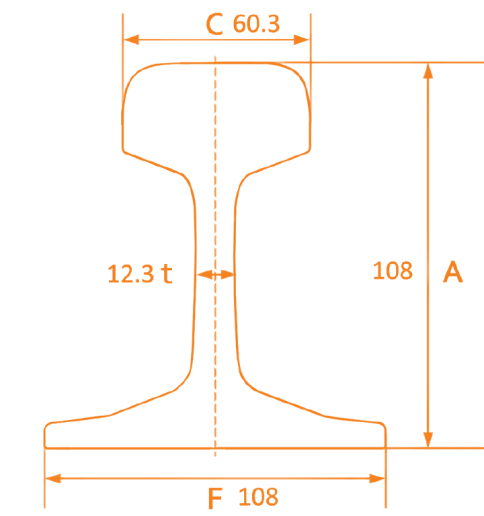The S30 rail is the heaviest profile in the DIN 5901 light rail series, engineered for high-load applications that require exceptional structural stability and durability. With a theoretical weight of approximately 30 kg per meter, this rail is designed to handle continuous stress and resist abrasion, ensuring a long service life. It is an ideal, cost-effective solution for a variety of medium-to-heavy duty transport systems.
Specification
| Specification | Value | Unit |
| Rail Profile | S30 | – |
| Standard | DIN 5901 | – |
| Rail Height | 108.0 | mm |
| Base Width | 108.0 | mm |
| Web Thickness | 12.3 | mm |
| Standard Length | 6m−10m or up to 12m | m |
| Material Options (Tensile Strength) | Q235B (375 MPa) / 55Q (540 MPa) | MPa |
| Calculated Mass / Weight | 30.03 or 30.1 | kg/m |
| Head Width | 60.3 or 60.0 | mm |
Key Features and Benefits
The DIN S30 rail is engineered for maximum performance and reliability in demanding industrial environments.
- Heaviest Light Rail Profile: As the heaviest profile in its series, the S30 rail offers a significant increase in load-bearing capacity and stability, making it suitable for applications where lighter rails would be insufficient.
- Excellent Structural Stability: The rail’s robust dimensions and symmetrical profile provide superior resistance to deformation and abrasion, which is essential for ensuring smooth operation and reducing maintenance costs in high-stress environments.
- European-Standard Compatibility: Manufactured to the DIN 5901 standard, the S30 rail offers proven compatibility with European rail systems and accessories, simplifying procurement and installation.
Applications
The S30 rail is a versatile product widely used in a variety of high-load industrial and infrastructure environments:
- Heavy Equipment Transport: Provides a stable and durable track for moving heavy machinery and equipment within factories and industrial yards.
- Industrial Cranes: Ideal for use in overhead crane systems and gantry tracks that require a strong and reliable foundation.
- Mines: Serves as a robust transport line for conveying materials, equipment, and personnel within mines.
- Factory Transport Lines: Used for internal rail systems that handle high volumes of material or heavy loads.

